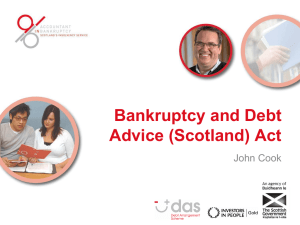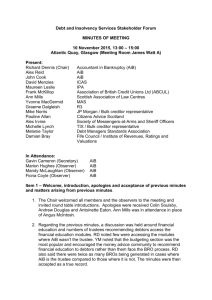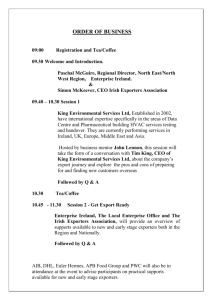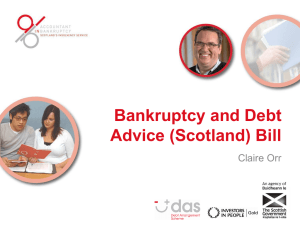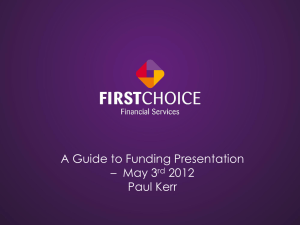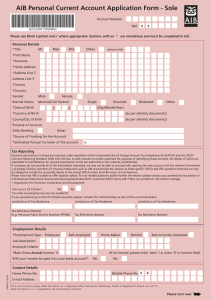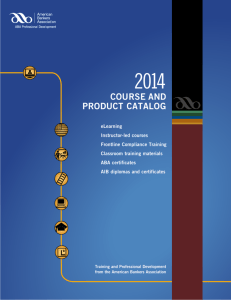AIB 4 PAGE A4 - Business 2000
advertisement
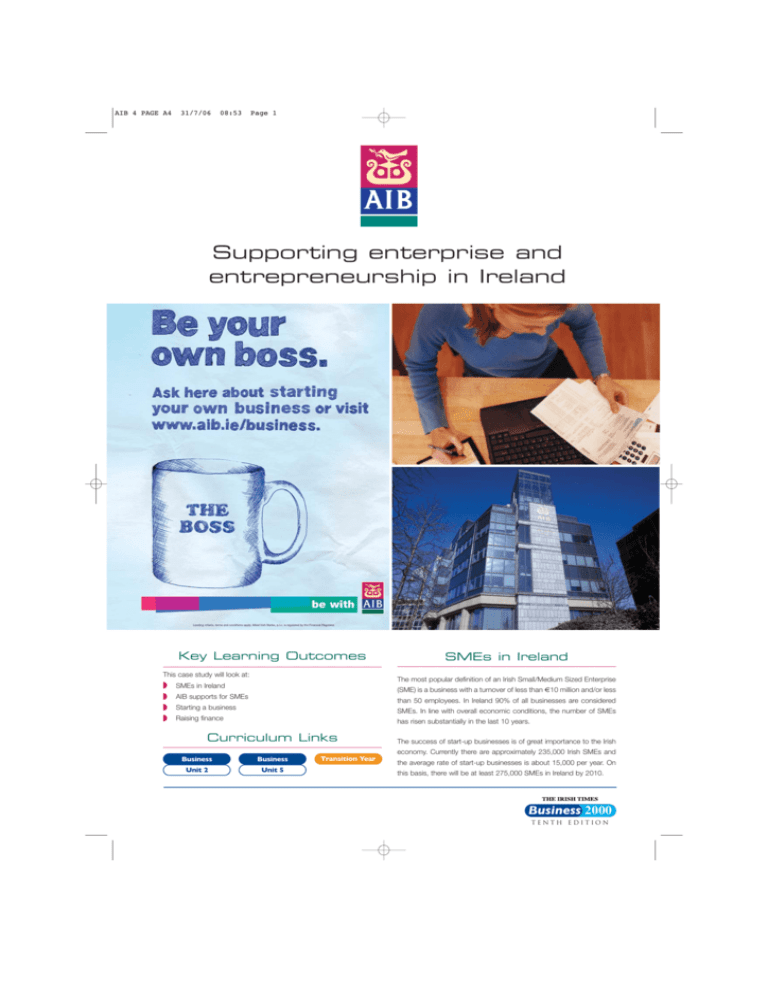
AIB 4 PAGE A4 31/7/06 08:53 Page 1 Supporting enterprise and entrepreneurship in Ireland Key Learning Outcomes This case study will look at: Q Q Q Q SMEs in Ireland The most popular definition of an Irish Small/Medium Sized Enterprise SMEs in Ireland (SME) is a business with a turnover of less than €10 million and/or less AIB supports for SMEs than 50 employees. In Ireland 90% of all businesses are considered Starting a business SMEs. In line with overall economic conditions, the number of SMEs Raising finance has risen substantially in the last 10 years. Curriculum Links The success of start-up businesses is of great importance to the Irish economy. Currently there are approximately 235,000 Irish SMEs and Business Business Unit 2 Unit 5 Transition Year the average rate of start-up businesses is about 15,000 per year. On this basis, there will be at least 275,000 SMEs in Ireland by 2010. Business 2000 Tenth edition AIB 4 PAGE A4 31/7/06 08:53 Page 2 AIB are also major sponsors and participants with the Small Firms Association (SFA), Chambers of Commerce and other lobby groups. In 2006, AIB co-sponsored the SFA Better Business Show offering simple but practical tips on managing costs. AIB has committed significant funding to create venture capital funds and build incubation centres for the SMEs of tomorrow. Incubation centres offer business and management development services and networking capabilities to provide entrepreneurs with a solid platform for starting and growing a business. Starting a business The three most common types of business structures are: 1. Sole Trader SMEs are created by entrepreneurs to satisfy consumer demand and A sole trader operates a business on their own. They are generally exploit market opportunities. Unfortunately, business failure remains a small businesses and the business person maintains total ownership business reality. Not all new enterprises will make it beyond their fifth and control. year in operation. To avoid business failure, business people need to have a sound business idea, follow a comprehensive plan and have 2. Partnership A partnership is where two to 20 people form a business together. All access to adequate funding. partners can be involved in running the business, but sometimes a Entrepreneurs must research their market thoroughly and keep up to date with changes in the business environment. They also have to delegate tasks effectively so they can concentrate on managing the business and ensure prudent cash management. Business owners/managers must also try to protect the business from insurable risks but it is not possible to insure any business against all possible risks. AIB’s support for SMEs partner is ’sleeping’ or ‘silent’ – they have invested money in the business, but are not involved in running it. 3. Company A company is a separate legal entity owned by shareholders. It is totally separate from the people who own and run the business. A private limited company can have up to 50 members who can trade their shares privately. A public limited company has more than seven members and shares are traded on the stock markets. AIB has a proven record of supporting existing and new/early stage Researching Business Ideas companies. AIB provides a range of banking facilities and supports The first step in setting up a new business is to research the business which help businesses operate successfully. This in turn underpins idea thoroughly. hundreds of thousands of Irish jobs. AIB invests heavily in staff training to ensure that employees Q Decide which products/services This involves researching a product/service’s design, uniqueness, understand SME requirements. At AIB, every SME has a personal quality assurance, legal requirements, production process, branding, Relationship Manager to look after their needs. distribution, projected customer-base, contribution to turnover, life span and if a product or production processes can be patented, AIB also has strict lending guidelines to ensure that the interests of copyrighted or trademarked. both the bank and the business are protected. Q Identify customers AIB has a large range of products, services and publications for SME Market research helps to assess if there is a market for products customers. Over the years, the bank has pioneered new initiatives that and services, to gauge the characteristics of that market, define focus on the real needs of SME customers. For example, AIB was the the customer base and establish a geographic boundary for the first bank to introduce interest bearing current accounts. These market. One key element for good business is good information accounts are useful for customers who need to keep large credit about customers, competitors and the market. The overall goal of balances on current account for their short-term cashflow needs. market research is to get the most useful information in the most cost-effective and realistic fashion. There are a variety of research AIB’s dedicated business website www.aib.ie/business has a large methods available, including questionnaires and focus groups. amount of valuable information on products and services for SMEs as Ideally, a combination of methods of desk and field research well as Guides, Features and Wizards, to help SMEs develop plans should be used. Other more cost effective sources of information and calculate financials. include internet searches, libraries and trade publications. AIB Supporting enterprise and entrepreneurship in Ireland AIB 4 PAGE A4 Q 31/7/06 08:53 Page 3 Know the competition There are a number of initial requirements for a business premises, Knowing the competition, what they offer, the terms on which they including a telephone line, computer, printer, fax and furniture. do business, how they can be a threat and what their weaknesses Specialist equipment and vehicles may also be required. The business are can be very beneficial to a new business. Much of this person needs to consider whether they can pay for these from their information can be obtained from field research or desk research own money or if a loan/lease or grant is required. - telephone directories, business brochures, follow-up telephone Raising finance calls, trade magazines and the Internet. Q Source suppliers The availability of finance is an important driver of success for early Suitable suppliers will have to be identified, along with their stage companies. The type and amount of finance that can be raised attributes, strengths and weaknesses. One single supplier should is determined by the creditworthiness of the business, the purpose for not be relied upon, as if they have difficulties in providing the which the money is required, the risks associated with the business quantity of stock required it could have a serious impact. and the collateral available, among other factors. Information on suppliers can be compiled from telephone Q directories, advertisements in trade publications, the Internet or Equity and Grants past experience. Equity can come from the business owner, friends, family, business contacts or venture capitalists willing to invest in the business. Set the price Enterprise Ireland and County and City Enterprise Boards provide The price charged will be determined by the benefits the grants and financial support for the start-up and expansion of small product/service offers to customers, and how much customers businesses. Once a grant/equity has been organised, an entrepreneur are willing to pay for those benefits. Unless the product/service will have more success securing bank finance. provides some very special or even unique benefit(s), it cannot command more than the going price. Business plan Internal Sources of Finance The cheapest source of finance for a business can be found within the business itself. If business leaders can collect money due from debtors quicker, negotiate longer credit or increased credit limits with suppliers A business plan is the blueprint for the business. It should clearly outline who the business person is, the target market, who the competitors are, the business objectives, the marketing plan, or reduce average stocking levels in proportion to sales, they will have to borrow less money to fund working capital. Overhead and staffing costs may have to be more tightly controlled too. financials and other factors relevant to the business sector. Documenting everything in a business plan gives an entrepreneur a greater sense of control and confidence. It will also tell how much money is needed and when it will be needed. It can also be used to convince bankers, investors or strategic partners of the financial viability of the business and to attract key employees. Bank Finance When applying for a loan, a business person needs to convince the bank that they are a good investment. They must prepare thoroughly before meeting with the lender and ensure they have all relevant documentation available. A comprehensive business plan, including the financials of the business will be required. These may include Forecast Trading Profit and AIB’s “A Practical Guide to Starting Your Own Business” brochure, Loss Accounts, Cashflow Forecasts, a Breakeven Analysis, Personal available on AIB’s business website contains a business plan and Business Bank Statements and Tax Receipts. The business template. AIB’s Business Plan Wizard guides entrepreneurs through owner/manager will also have to convince the bank of their good each step of writing a business plan. character, management capability, and capacity to repay the finance. Security may be required e.g., the loan may be secured by identifiable Locating a business business and personal assets, such as land and/or buildings. Entrepreneurs might decide to operate the new business from home in the initial stages. If so, they need to consider if they will have enough room with space for equipment. If they rent a business premises, they will need to consider the size and facilities available, rental costs, the lease term, when they can move in and how much notice they must give to leave. If an entrepreneur decides to buy a business premises, they must consider the size and cost of the premises, if the title to the property is leasehold or freehold and if there are competitors located close by. If a loan is required to fund the premises, they must consider the amount required and the repayments, the term of loan and what security they can provide. www.business2000.ie 31/7/06 08:53 Page 4 Banks offer various forms of finance depending on the business needs, including short-term/working capital finance to facilitate day-to-day operations, medium-term loans, leasing and hire-purchase, and longterm finance for fixed assets. Bank finance is extensively used by SMEs, to fund start-up and ongoing capital requirements. It is estimated that by 2010, total business lending by banks will exceed €100bn. Management & Organisational Structure Due to the size and structure of many SMEs in Ireland, a business owner/manager has to have a detailed knowledge across numerous key business areas, e.g. finance, HR, IT, marketing, sales. Large SMEs normally have a management team of staff who are responsible for key areas, e.g. financial controller, head of sales/marketing, who report directly into the business owner/manager. Ensuring staff have clear roles and accountabilities is critical for all enterprises, including family owned and operated business, which account for approximately 75% of SMEs in Ireland. This helps avoid conflict and misunderstandings. A good succession plan is also required to prepare for the smooth transition of ownership and control of the business to a family member or employee when required. Conclusion There are many risks involved in starting a business. While risk is an essential element in business, it can be assessed and managed through proper analysis and planning and by taking advantage of the many supports available. AIB understands the requirements of startup businesses in Ireland today. The bank has educated its staff and introduced SME specific products and services to meet the needs of this segment of its market. By customising its products and services and providing support to its business customers, AIB offers improved services, helping to retain existing customers and attract new customers. Task & Activity Using the template provided, prepare a Business Plan from the following information. Billy Jean Gates and Joan Scully are lifelong friends. Billy Jean holds a Masters degree in Computer Applications and for the last 10 years has worked for the Pear Computer Company. Joan has an MBA and has worked with Ireland’s premier Marketing Company for the same length of time. For the last year they have been working on software that they believe will revolutionise waiting lists in Irish hospitals. In the short term they have the following Cashflow requirements. Q Annual wages for their staff €120,000, leasehold of premises €130,000, advertising/marketing €30,000, miscellaneous €50,000. Q Billy Jean has €30,000 in savings and a promise from her family of another €20,000. Joan has €20,000. Wexford County Enterprise Board has pledged up to €50,000 in grant aid. They have approached AIB to borrow the balance. AIB would like to see their Business Plan. You can make whatever assumptions you wish. Name of Business Managers’ Background Description of Product/Service Glossary Marketing Details Breakeven Analysis: A mathematical method for analysing the relationships among a firm's fixed costs, profits, and variable costs to calculate the costs of running a business. Cashflow: The amount of cash a company generates and uses during a period, calculated by adding non-cash charges (such as depreciation) to the net income after taxes. Cashflow can be used as an indication of a company's financial strength. Incubation Centres: An environment that provides the entrepreneur with a solid platform for starting and growing a business. Low-cost space and shared services reduce overheads in the crucial early development stage of a new enterprise, and the constant availability of practical business advice and assistance contributes to the long-term survival and success of the business. Public Limited Company: A company that issued securities through an initial public offering and which are traded on at least one stock exchange. Private Limited Company: Private companies may issue stock and have shareholders. However, their shares do not trade on public exchanges and are not issued through an IPO. Business 2000 Tenth edition Premises & Equipment Finance Required Details of Cashflow Find out more Visit: www.aib.ie www.business2000.ie While every effort has been made to ensure the accuracy of information contained in this case study, no liability shall attach to either The Irish Times Ltd. or Woodgrange Technologies Ltd. for any errors or omissions in this case study. AIB 4 PAGE A4
